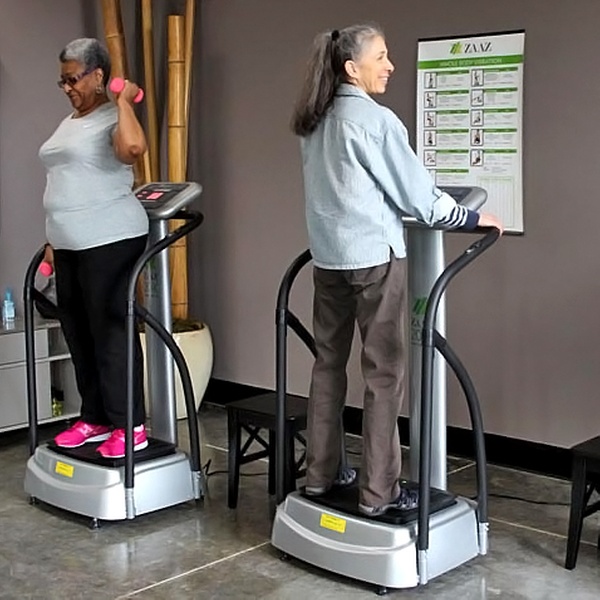“Osteoporosis is not an inevitable part of aging: it is preventable. So, it is vital that all of us, of all ages, start taking care of our bones now before it is too late” [1].
Osteoporosis may not be inevitable but weak bones sure are common among the over 60 crouwd. According to research, one in ten older Americans has osteoporosis.Further, more than 34 million Americans have osteopenia.
I have learned about the importance of bone health aka bone mineral density because I have a blood cancer called multiple myeloma. MM can eat bones and can cause both osteoporosis and osteopenia. More importantly, I underwent a number of toxic therapies leaving me with short, long-term and late stage side effects- many that are bone and joint related.
One of the best ways to avoid a diagnosis of multiple myeloma is to keep your bone healthy. The best way to keep your bone healthy is through
- Exercise
- Whole-body vibration
- Nutrition
- Supplementation
The study linked and excerpted below focuses on exercise in general and whole-body vibration in particular. WBV has been shown to enhance bone health. And frankly, I have found this exercise to be easy to do…daily. Right before bed, in fact.
Keep in mind that I am handicapped. Years of conventional toxic therapies including radiation, caused long-term problems with my nerve conduction. But that’s another blog post.
Do you have osteoporosis or osteopenia? Scroll down the page and send me a question or a comment and I will reply with information about bone building nutritional supplementation.
Hang in there,
David Emerson
- Cancer Survivor
- Cancer Coach
- Director PeopleBeatingCancer
Recommended Reading:
“The aim of this review is to analyze previously conducted randomized controlled trials and investigate the relationship between various exercise regimes and their effect on bone mineral density in postmenopausal women. To determine whether exercise can be used as a non-pharmacological modality for osteoporosis prevention, a thorough search was performed on various databases (PubMed, ScienceDirect, and Google Scholar).
Only bone mineral density studies and trials with intervention versus control groups were included, and 13 randomized controlled trials were deemed relevant. The majority of trials concluded that exercise positively impacted bone mineral density in postmenopausal women. High-impact exercises seem to have the most significant effect on bone mineral density due to compression, shear stress, and high loading on the bone, causing bone remodeling. Considering all the limitations, exercise seems to be an effective tool for preventing postmenopausal osteoporosis…
Clinical osteoporosis is defined as the loss of quality and integrity of the microstructure of the bone, decreased bone mineral density (BMD) (≤ -2.5 standard deviation [SD]), and therefore heightened fracture risk [4]. Osteopenia is associated with intermediate fracture risk where the value of BMD is between 1 and -2.5 SD below peak bone mass [5]…
Despite the effectiveness of different pharmacological treatments, increased cases of poor long-term compliance and adverse drug effects [10] have led to exercise becoming an effective non‐pharmacological approach for maintaining bone health and preventing bone resorption, but with none of the side effects [11]…
Across all three databases, a total of 1,205 articles were identified after the removal of duplicate articles through the software Endnote. At the first stage of screening, 1,128 articles that we felt would not have contributed to this review were removed. After stage 2 screening, we ended up with a total of 13 articles. The study, intervention, and conclusions (effect on BMD) are presented in Table 4…
Discussion-
Bone health and aging are two concerns that commonly walk hand in hand. Aging is associated with bone demineralization, most commonly after the third or fourth decade [27], which can lead to spontaneous fractures, especially in women with estrogen deficiency [22].
Various strategies have and are being explored to negate the structural degradation of bone tissue. Physical activity has been considered a low-risk, low-cost treatment preference and is continually becoming a popular option. Maintaining bone density or preventing bone loss, in turn, helps reduce falls and fractures, improving patients’ health-related quality of life (HRQoL) [21,28]..
Whole-Body Vibration Training
WBV has increasingly become an attractive option, especially for patients who cannot tolerate weight-bearing exercise prescriptions, such as those with joint, muscle, and nerve diseases [26,28,29]. It is an exercise where subjects stand straight on a platform, and the stimulation source transmits vibration vertically through the body [26,29]. WBV is shown to cause direct bone growth and stimulation by modifying bone fluid flow…
Is There a Minimum Threshold Needed to Induce BMD Changes?
We decided to analyze articles with the shortest intervention period, those between 24 and 26 weeks, to answer this question. We perceived that women diagnosed with osteopenia made more significant and faster increases in BMD in a shorter period [21,26,28]than those who were healthy [27,30]…
Conclusions
The compilation of articles reviewed, in the majority, demonstrated that physical activity has improved or at the very least maintained BMD in postmenopausal women.
The detrimental effects of a sedentary lifestyle have also been established. Every study that included high-impact training has positively impacted BMD, concluding that postmenopausal women should incorporate physical activity into their day-to-day routine. The earlier the exercise regime begins, the less the bone loss, as women lose the most density in early menopause (first one to eight years), and it ensues into a period of lower rates of bone loss.
Activities should be continued lifelong to avoid losing previously obtained bone mineralization. If unable to perform high-impact exercises that overload the bone and joints, the secondary option is to enroll in aquatic exercise programs that intertwine high-intensity sequences. As reviewed above, aquatic programs involving bone stimulation with substantial skeletal loading significantly affect BMD and should be considered a great second option.
It is necessary to conduct more randomized control trials with larger sample sizes and more extended follow-up periods to expand our knowledge in this research area and form the perfect individualized prescription for preventing osteoporosis and its related fractures…”



